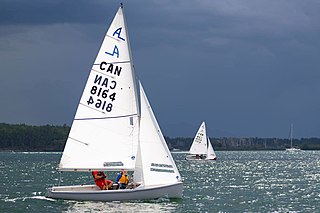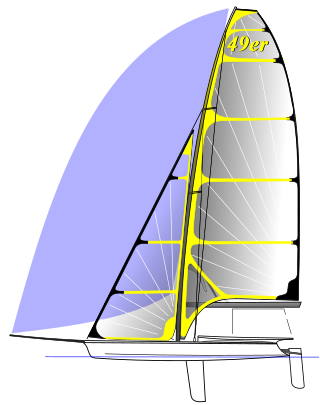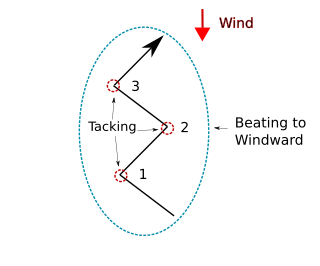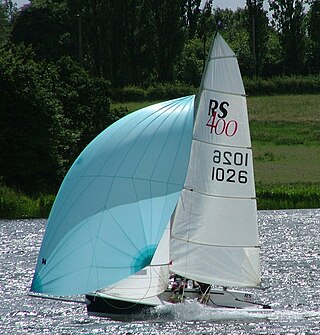Events
World Championships
| Event | Gold | Silver | Bronze |
|---|---|---|---|
| 2007, Whitby | |||
| 2010, Rutland | |||
| 2012, Sydney | |||
 2016, Medemblik | |||
 2018, Hiroshima | |||
 2023, Portimao |
| Boat | |
|---|---|
| Crew | Single |
| Draft | 0.9 m (2 ft 11 in) |
| Hull | |
| Hull weight | 52 kg (115 lb) |
| LOA | 2.3 m (7 ft 7 in) |
| Beam | 1.25 m (4 ft 1 in) |
| Rig | |
| Mast length | 4.2 m (14 ft) |
| Sails | |
| Mainsail area | 3.8 m2 (41 sq ft) |
The Access 2.3 is a single-crew cat rigged sailing keelboat, which is recognised by the International Sailing Federation as an international class. [1] It is typically regarded as being a beginner's dinghy. [2]
The Access 2.3 differs from the majority of dinghies in that is controlled by a joystick, rather than a tiller, and the single crew is seated facing forwards. The crew does not switch sides during a tack and the boom is rigged high so as to avoid the helm's head during a tack. [2]
The boat is generally regarded as being a good beginner's boat for someone new to sailing, due to its stability and the ease with which it can be sailed. [2] [3]
Because the boat can be equipped with servo assist electric controls it is possible for those with physical disabilities to sail it by themselves. [3]
There is also a wide version of the Access 2.3 which can accommodate for two average sized adults, although it is still capable of being sailed by a single crew. [4]
| Event | Gold | Silver | Bronze |
|---|---|---|---|
| 2007, Whitby | |||
| 2010, Rutland | |||
| 2012, Sydney | |||
 2016, Medemblik | |||
 2018, Hiroshima | |||
 2023, Portimao |

Dinghy sailing is the activity of sailing small boats by using five essential controls:

A jibe (US) or gybe (Britain) is a sailing maneuver whereby a sailing craft reaching downwind turns its stern through the wind, which then exerts its force from the opposite side of the vessel. It stands in contrast with tacking, whereby the sailing craft turns its bow through the wind.
The Mirror is a type of popular sailing dinghy with more than 70,000 built.

Dinghy racing is a competitive sport using dinghies, which are small boats which may be rowboats, have an outboard motor, or be sailing dinghies. Dinghy racing has affected aspects of the modern sailing dinghy, including hull design, sail materials and sailplan, and techniques such as planing and trapezing.

The Albacore is a 4.57 m (15 ft) two-person planing dinghy with fractional sloop rig, for competitive racing and lake and near-inshore day sailing. Hulls are made of either wood or fiberglass. The basic shape was developed in 1954 from an Uffa Fox design, the Swordfish. Recent boats retain the same classic dimensions, and use modern materials and modern control systems.

The Laser is a class of single-handed, one-design sailing dinghies using a common hull design with three interchangeable rigs of different sail areas, appropriate to a given combination of wind strength and crew weight. Ian Bruce and Bruce Kirby designed the Laser in 1970 with an emphasis on simplicity and performance.

The 49er and 49er FX is a two-handed skiff-type high-performance sailing dinghy. The two crew work on different roles with the helm making many tactical decisions, as well as steering, and the crew doing most of the sail control. Both of the crew are equipped with their own trapeze and sailing is done while cantilevered over the water to the fullest extent to balance against the sails.

Tacking or coming about is a sailing maneuver by which a sailing craft, whose next destination is into the wind, turns its bow toward and through the wind so that the direction from which the wind blows changes from one side of the boat to the other, allowing progress in the desired direction. Sailing vessels are unable to sail higher than a certain angle towards the wind, so "beating to windward" in a zig-zag fashion with a series of tacking maneuvers, allows a vessel to sail towards a destination that is closer to the wind than the vessel can sail directly.

In sailing, hiking is the action of moving the crew's body weight as far to windward (upwind) as possible, in order to decrease the extent the boat heels. By moving the crew's weight to windward, the moment of that force around the boat's center of buoyancy is increased. This opposes the heeling movement of the wind pushing sideways against the boat's sails. It is usually done by leaning over the edge of the boat as it heels. Some boats are fitted with equipment such as hiking straps and trapezes to make hiking more effective.

The Cadet is a class of sailing dinghy designed to be sailed by two children up to the age of 17. It is a one-design class, originally designed by Jack Holt in 1947. Cadets are sailed worldwide in more than 40 countries.

The Fireball is a British sailing dinghy that was designed by Peter Milne as a one-design racer and first built in 1962.

A fractional rig on a sailing vessel consists of a foresail, such as a jib or genoa sail, that does not reach all the way to the top of the mast.
Sail Canada is Canada's governing body for the sport of sailing. Sail Canada is a "Member National Authority" of World Sailing. Organization of sailing in Canada is divided into four groups: yacht clubs, Provincial Sailing Associations, class associations, and Sail Canada itself.

A trailer sailer is a type of sailboat that has been designed to be easily transported using a boat trailer towed by an automobile. They are generally larger than a sailing dinghy. Trailer sailers include day sailers and small cabin cruisers, suitable for living on.

The RS400 is a light-weight sailing dinghy designed by Phil Morrison and manufactured by RS Sailing. The dinghy is sailed by two people and has a main, a jib and an asymmetric spinnaker. It has a PY of 948 and a D-PN of 82.3.

The SKUD 18 is a class of racing sailing boat. It is a lead-assisted skiff with a tube-launched asymmetrical and a modern high performance stayed rig. The boat was created for trials held by the International Association for Disabled Sailing who were looking for a new two person boat for an additional medal allocated to sailing for the 2008 Paralympics.
The Access 303 is a single or two crew sailing keelboat, which is recognised by the International Sailing Federation as an international class. It is typically regarded as being a beginner's dinghy.

The RS Tera is a one-man monohull dinghy in the RS Sailing range of sailing boats. It is recognised by the International Sailing Federation (ISAF) as an international class, and is a popular boat for beginners and for children to race.

The lug sail, or lugsail, is a fore-and-aft, four-cornered sail that is suspended from a spar, called a yard. When raised, the sail area overlaps the mast. For "standing lug" rigs, the sail may remain on the same side of the mast on both the port and starboard tacks. For "dipping lug" rigs, the sail is lowered partially or totally to be brought around to the leeward side of the mast in order to optimize the efficiency of the sail on both tacks.
The Impulse 21, also called the Impulse Eagle, is an American trailerable sailboat that was designed by William E. Cook as a one-design racer and day sailer, It was first built in 1986.